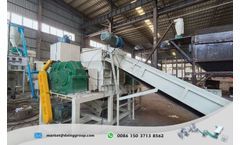Refine by
Solar Cell Articles & Analysis
174 articles found
Summary Algae growth negatively impacts power generation efficiency by obstructing water flow, increasing maintenance costs, and causing potential revenue losses due to downtime. Real-time monitoring combined with non-chemical prevention strategies enhances algae management, ensuring efficient power generation and promoting the ecological health of aquatic ecosystems. Algae can significantly ...
One of the most promising applications of PQDs is in solar cells. Researchers have demonstrated that PQDs can be used as active layers in photovoltaic devices, which can significantly increase their efficiency. ...
In particular, high-purity sputtering targets are used in the physical vapor deposition (PVD) process for the manufacture of electronic components, and are key materials for the preparation of surface electronic films such as wafers, panels, and solar cells. In a vacuum state, accelerated ions are used to bombard the solid surface. ...
In addition, the photovoltaic industry also has a great demand for copper because copper has strong electrical conductivity and is mainly used in the cells and balance systems of photovoltaic modules. In the field of high technology, high-purity copper also plays an important role. ...
DOING's frame removal machine has no restrictions on the specifications and damage degree of various photovoltaic panels, and can process photovoltaic panels of various forms, regardless of their size or degree of damage, they can be effectively processed. 2.Photovoltaic panel glass removal machine: The glass removal machine is responsible for separating the solar ...
Silicon cells, although requiring complex processing, can be recycled and reused in the production of new solar cells. ...
Organic Photovoltaics: mCP is used in organic photovoltaic devices to improve charge transport and enhance the efficiency of the solar cells. It helps in converting sunlight into electricity efficiently. ...
The electron transport layer in perovskite solar cell (PSC) is composed of electron transport materials (ETM). The perovskite light-absorbing layer forms electron-selective contact with the ETM, and the ETM extracts and transfers photogenerated electrons from the perovskite layer, which can effectively block the movement of holes toward the cathode and prevent ...
In the field of electronics, fullerene has been utilized in organic photovoltaic cells, where its ability to absorb light efficiently and transport charge makes it an ideal material for solar energy conversion. The incorporation of fullerene derivatives into the active layer of solar cells enhances their efficiency and stability. ...
ByMatexcel
Additionally, they can be utilized as a useful tool for monitoring cancerous cells and providing a means to better understand their evolution. Solar Cells and Photovoltaic Devices: Due to quantum dots have the ability to preferentially absorb and emit radiation, they can generate optimal electric current and voltage. Utilizing quantum dots allows ...
Semiconductor solar cell is the fastest growing and fastest clean energy cell in the world. Photoelectric conversion rate is the main standard to judge the quality of solar cells. The higher the conversion rate, the more efficient the solar cell will be. According to the ...
One specific use of etchants in energy applications is in the production of solar cells. Solar cells harness sunlight to generate electricity, and the efficiency of these devices depends largely on the quality of the semiconductor material used. ...
In the multilayer structure of perovskite solar cells (PSCs), the core is the photoactive layer that absorbs light. ...
Recycling solar panels can be a lucrative business, as it involves the recovery of valuable materials from used solar panels and converting them into new products or components. Here are tips on how to start a solar panel recycling business and make money. 1. Research and market analysis: Before launching a solar panel recycling ...
One of the reasons why formamidinium iodide perovskite is so attractive for use in solar cells is because of its high PCE. PCE refers to the amount of energy from sunlight that can be converted into electrical energy by a solar cell. A higher PCE means that a solar cell is more efficient at ...
Transparent conductive films: Graphene conductive ink can be used to coat surfaces with a thin, transparent layer of graphene, making it suitable for applications such as touchscreens, solar cells, and flexible displays. 3D printing: Graphene conductive ink can be used in 3D printing to create complex structures with conductive properties, such as antennas, ...
The triphenylbenzene derivatives semiconductor thin film can be applied to electrophotographic devices as a hole transport layer, and can also be applied to solar cells as an organic p-type semiconductor film. Light-emitting materials: For triphenylbenzene derivatives, light-emitting materials with excellent comprehensive properties can be obtained by optimizing ...
Introduction The photosensitizers absorb photons and have a wide spectral absorption range, which is an important part of the dye-sensitized solar cells (DSSCs) and directly affects the energy conversion efficiency of the cell. ...
In organic solar cell (OPV) devices, the most important part is the organic active layer. ...
PQDs have gained attention in recent years for their potential use in optoelectronic devices such as solar cells, LEDs, and photodetectors. However, the stability of PQDs is a major issue, and TBABF4 has been found to mitigate this problem by preventing oxidation, agglomeration, and degradation of the PQDs. ...







